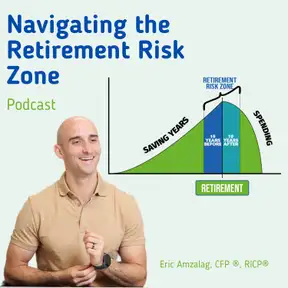Is The 1% Rule Actually Worthwhile in Retirement?
When is a one-off financial
planning fee appropriate?
And when is a percentage of assets
under management fee appropriate.
Everyone has opinions about these matters
and today I'm going to share mine with you all.
To begin,
I believe that despite getting a lot of
lip service, the substance beneath the
what should I pay for retirement
planning or investment advice
question is rarely given
the specificity it deserves.
The question is why?
In my opinion, most financial advisors
and retirement planners
don't actually have a solid way
to substantiate what they're providing.
My opinion is that we should really be
thinking of a financial plan,
or a retirement plan as a distinctly
different product than investment advice.
In the traditional financial landscape,
you, the consumer, are gated
from obtaining a plan
or getting qualified advice until you form
an assets under management relationship
with an investment advisor.
In other words, you have to make one
of the riskiest decisions of your life
to turn over investment direction
of your lifetime accumulated savings
to essentially a stranger before
you can get the answers to the questions.
When can I retire
and what can I spend if I retire tomorrow?
Now, this is an undeniably terrible
pricing model that heavily favors
the financial institutions
at the expense of you, the consumer.
Now, does that mean that a percentage of assets
under management is an inappropriate fee?
And the answer to that,
in my opinion, is no.
And AUM or assets under management
fee can be appropriate in many scenarios.
It just should not be the starting point
for a financial advice relationship.
Starting a relationship with an AUM
fee would be like
getting a new job, and then getting paid
your annual bonus on day one.
The incentive structures
are just totally out of whack.
Now, earlier
I said that I believe that we should be
thinking about a financial plan
as a distinctly separate service
or product from investment advice.
My opinion is that a plan is the first
step in any process that includes risk.
So your financial plan should inform
and dictate
how your investments are constituted
and not the other way around.
And yet, the majority of the industry
would have you believe that you should
first invest and then plan your life
around those investments.
Now, to me, that's crazy.
That's kind of like shooting the gun
first and aiming later.
What problems should an investment
relationship seek to solve?
And what problems should
a financial plan seek to solve?
Now, a financial plan should
answer the following questions.
One.
Based on when I want to retire,
how much do I need to save each year?
Two.
Based on my current
accumulated wealth,
when is the earliest that I can retire?
Three.
Based on my desired
spending in retirement,
how much income will my portfolio
be responsible for producing?
And then fourth.
Based on the answers
to all the above questions,
what investment rate of return
do I need to target in order to make
my plans a reality?
Now, the investment relationship should
seek to solve the following problems.
How do I invest my funds in order to meet
or exceed the target
rate of return,
as determined by my financial plan?
Number two,
how do I invest my funds in the best
risk adjusted way
as determined by my financial plan?
Three.
How often and how should I measure
the risk of my investment portfolio
as determined by my financial plan?
Number four,
how and how often should I
make changes to the investment
composition of my portfolio
consistent with my financial plan?
Five.
How should I take withdrawals
in the most tax efficient manner
consistent with my financial plan?
And then six.
What recurring quarterly
or annual activities should I
or chould I take with my portfolio
to improve the risk reward ratio
in accordance with my financial plan?
Now, the way I see it,
all investment related concepts
should be informed
and dictated by one's financial plan.
So the question now is how do I tie all
this back to the pricing or fee question?
Well, I see it quite simply.
First, according to the logic
that I've laid out so far,
the proper place to begin
is always with a financial plan.
Okay, so if we do intend to begin
with a financial plan,
then what's the appropriate amount
or way to pay?
The first answer is it's
never right to pay $0.
See nothing is ever truly free.
It's either free
because the quality will be poor,
and the risk you take on as
a consumer is so high
that the service can
only be sold for free.
Or it's free, because
the provider knows
they will make up
for the cost of the effort on the back end
in ways that you as a consumer
are not aware of upfront.
So to me, the appropriate financial
planning relationship is one where it's
either a flat fee or a quoted fee
based on scope of work that's transparent
and has no strings attached
beyond the original financial plan.
And this means a financial plan
with a transparent price for the work
and the deliverables, with no attachment
to any future investment
relationship built into the original
financial planning agreement.
Now this reduces conflicts of interest.
The planner has to quote a fair
and appropriate fee to deliver the plan.
And the consumer, meaning you,
know exactly what you will pay
and what you will receive in return.
You as a consumer will get answers
to the following four
questions that we said earlier.
Based on when I want to retire,
how much do I need to save each year?
Based on my current accumulated wealth,
when is the earliest that I can retire?
Based on my desired spending in retirement,
how much income will my retirement
portfolio be responsible for?
And then, based on all the preceding
answers, what investment rate of return
do I need to target to
make my plans a reality?
Then a separate working agreement
with a separate
fee structure can be engaged
for an investment relationship.
In fact, it's actually my opinion
that in the optimal scenario,
one would work under two arrangements
with the same financial provider.
A primary entry engagement for a financial
plan that helps provide the plan --
The education.
And establish a relationship
based on competence.
If the work of building the financial plan
with that professional proves
that the person or company
has the expertise,
the quality of character,
and the competence
to provide a financial plan
that solves the key retirement problems,
then it can make sense to use
that same professional
for an investment relationship.
That is, if you are indeed even seeking
an investment relationship.
And if you are seeking an
investment relationship,
delegate those core activities,
then yes, an AUM fee, in
my opinion, is the appropriate fee.
Now, to be clear, in my opinion, it's
entirely okay to want a financial plan
without wanting an investment
relationship.
The manner that I've described so far
in this video and podcast allows for that.
But if you do want an investment
relationship
because you don't want to be responsible
for those six key investment outcomes,
then my opinion is that we want to avoid
discount investment services.
Because it will inevitably be the case
that a discount service
will eventually need
to reduce their level of service
or individual attention
as their client base grows.
And if you, like me, agree
that an investment
relationship is a big risk
and that we should go through great pains
to not only determine if it is warranted,
but also to determine
who that professional should be,
then an AUM or assets under management fee
is actually an exceptionally
good partnership model.
The advisor can manage their capacity
and provide more individualized attention
to each client, and the client can sleep
well at night knowing that the advisor
will not overload their client book
in pursuit of discount fee clients.
Now, again, to be clear,
just because an investment advisor charges
using an AUM or percentage based fee
does not make them
a good investment manager
or financial planner.
But using a process like what
I've described today in this video,
which is starting with a relationship via
a paid financial planning engagement
with no commitment
to an investment relationship,
and then using that financial planning
relationship to kind of try before you buy
You know what I mean,
to qualify the competence,
but more importantly,
the quality of character
of the professional is, in my opinion,
the optimal way to pursue
both the best financial plan, investment
advice and professional partnership.
Now, if you'd like to learn more
about the financial planning process
we use with clients at
Peak Financial Planning,
I've released a completely free webinar
that you can view
using the link in the description
to this podcast or video below.
Anyhow, thanks as always
for your time and attention
through the exploration
of financial advice fees
and I'll see you in the next video.
Creators and Guests


